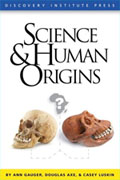| Welcome | August, 2012 |
Welcome to the ARN Announce email reports. These brief emails are sent out every few months to help you keep up with the top intelligent design news and resources at a glance, and provide you with quick links to more information. We also provide you with advanced notice of new products and special sales available only to our email subscribers. |
|
| Featured Products | |

Science & Human Origins The recent Hollywood SciFi movie, Prometheus, by Ridley Scott (2012), is a good reminder of how fascinated we are with the story of our own origins. Finding clues left by extra terrestrial beings, scientists funded by motivated entrepreneurs, leave on a galactic journey to find the “Engineers” who seeded life on earth. What they find surprises them, and while they find some answers to “who” created us, they are left with the more disturbing question of “why” they create us. Perhaps the movie provides us a little insight to the question of why every hominid bone discovery in Africa is hailed by anthropologists and media sources as the key missing link in explaining human origins. We just want to know where we came from. Standard scientific texts and news reports lead the average person to believe it has all been figured out according to Darwin’s theory. The new discoveries are just filling in a few missing gaps in the evidence. That could not be farther from the truth. Scientists are nowhere closer to knowing the “who” or the “why” based on the evidence than they were 50 years ago. We frequently get requests for good texts that provide a critique of the Darwinian theory of human origins. What are we to make of the latest fossil finds from Africa or the claim that our DNA is almost identical to that of the chimpanzee? Until now there has not been a definitive text—just an article here or a chapter there. We are happy to recommend this brief text on the topic that is written with a general audience in mind. The modern scientific creation story is that humans evolved from a common ancestor through the process of common descent and natural selection acting on unplanned genetic variations. The two lines of reasoning that are typically used to argue for our common ancestry with ape-like creatures are both based on similarity—similarity in anatomy, and similarity in DNA sequence. In this new book, Science & Human Origins, the authors take on both lines of argument and show that similarity between two complex structures does not reliably indicate an evolutionary path between them. In chapters 1 and 2, Ann Gauger and Douglas Axe challenge the central claim that Darwin’s undirected mechanism of natural selection is really capable of building a human being. In chapters 1, 3, and 4, Ann Gauger and Casey Luskin critically assess the genetic and fossil evidence that human beings share a common ancestor with apes. And in the final chapter, Ann Gauger refutes scientific claims that the human race could not have started from an original couple. So whether it’s for yourself, a high school or college student, or a friend at work, the next time someone claims that the fossil or DNA evidence proves we descended from a common ancestor according to Darwin’s theory, this is the book you want in order to start examining the evidence and arguments in greater detail. Like the scientists from the movie Prometheus, I think you will be surprised by what you find. Go here to order your copy of Science & Human Origins today. |
|
| ARN News Flash | |
|
|
ARN Announce is produced and distributed by Access Research Network. ARN Announce describes many of the upcoming events and new articles, books, videos and other resources on Intelligent Design. Please forward this message to several of your friends and colleagues to let them know about the resources available at Access Research Network (www.arn.org). Back issues of ARN-Announce can be found at www.arn.org/announce.htm. Access Research Network is a non-profit organization dedicated to providing accessible information on science, technology and society issues from an Intelligent Design perspective.
TO SUBSCRIBE: Send an email to "ARN-Announce-request@arn.org". The body of the message should consist of the word "SUBSCRIBE" and nothing else. Or visit the web page at http://arn.org/mailman/listinfo/arn-announce_arn.org and select Subscribe and enter your email address. You will receive a confirmation email indicating your name has been submitted to the list. Follow the directions and reply to the email and your email address will be added to the ARN-ANNOUNCE list. TO UNSUBSCRIBE: Send an email to "ARN-Announce-request@arn.org". The body of the message should consist of the word "UNSUBSCRIBE" and nothing else. Or visit the web page at http://arn.org/mailman/listinfo/arn-announce_arn.org and select Unsubscribe and enter your email address. Your email address will be automatically removed from this list. TO CHANGE YOUR EMAIL ADDRESS: To change your email address, retrieve your password, or change other subscription options, please visit the web page at http://arn.org/mailman/listinfo/arn-announce_arn.org and select the "edit options" button at the bottom of the page. |